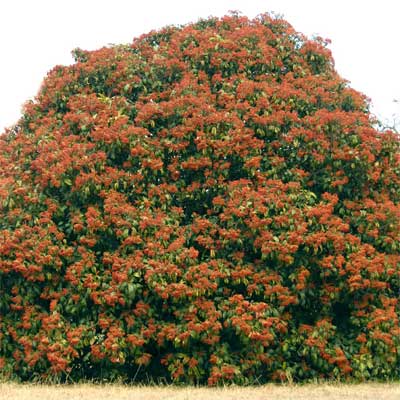Plant of the Month – February, 2008

Chinese Photinia
Photinia serrulata
Any veteran Texas gardener knows this old plant, either from firsthand experiences or by observing it in older Texas neighborhoods. There was a time when it was a mainstay plant, but that was an era of larger landscapes and taller screens.
A sister, redtip photinia hit the marketplace in the 1960s and it wasn’t long until they lined every fence and fronted every house. We trimmed them to whatever height we wanted, and we marveled at their fabulous spring color. They left their older sister behind in the dust.
But our old Chinese photinias kept plugging along.
Then, somewhere in the ’70s or ’80s, a fungal leafspot disease moved in and systematically ruined our redtips. First signs were maroon freckles on the leaves. Next came yellowed, even white foliage, then thinning, dieback and death. There was nothing we could do to turn them around.
And our old Chinese photinias kept plugging along.
Now, many of the state’s nurseries and landscape contractors refuse to handle redtips. They’ve moved on to other shrubs, and we all need to follow their lead.
Meanwhile, our old Chinese photinias are still plugging along. Those plants from the ’40s and ’50s are still growing strong, yet we’ve all but forgotten their name.
What you see in the photo is a 60-year-old Chinese photinia with possibly the largest crop of fruit I’ve ever seen on one plant. This photo, taken just days ago a few blocks south of the square in McKinney, is a spectacular example of why some of our old heirloom shrubs deserve a second chance in our gardens.
Chinese photinias grow to 15 to 18 feet tall and 10 to 12 feet wide. They have dark green, evergreen leaves that are gently toothed like a hacksaw on their edges. The spring flowers top glossy new growth. The clusters are white, and they are unpleasantly fragrant. The fruit ripens in the fall and holds until spring. New growth may show powdery mildew for a few weeks in the spring, but it is absolutely not threatening to the plants.
Ask for Chinese photinia when you go shopping. Your nursery probably won’t have it, but they might be able to order it in. It’s worth the hunt. Or, another option: gather some seeds from plants in your town and grow your own. They mature fairly quickly.

